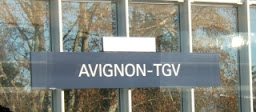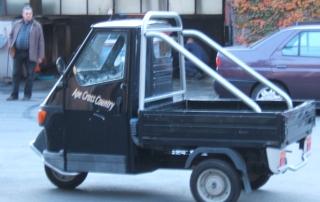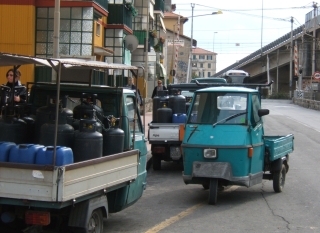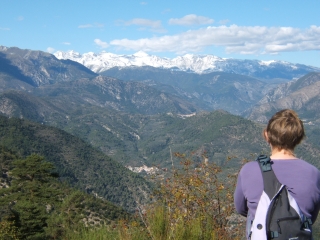Anxious car owners had already moved their cars up and away from danger and they watched from above as the flood inched its way over the gravel surface until the whole area was covered.
Thursday, December 31, 2009
Lupi New Year
Anxious car owners had already moved their cars up and away from danger and they watched from above as the flood inched its way over the gravel surface until the whole area was covered.
Saturday, December 19, 2009
Christmas in Italy
Whilst I was out on a stroll the other day, a few miles down the road in the village of Serro, I happened to glance up just as Santa was nipping into someone's house to leave some presents. The chances of catching him 'on the job', so to speak, must be very slim so I am rightly proud of this picture. The poor man had clearly started early and was working overtime, delivering in daylight, so rather than embarrass him I left him to it and walked on.
Tuesday, December 15, 2009
Wounded knee mountain
Saturday, December 12, 2009
Death and breasts in Lyon

Meanwhile back at the home of our hosts, Guy and Noëlle a deadly drama was being played out. A lone turtledove, one of many who share the garden with the hens, the tractors and the various assorted bits of machinery, was in full flight trying to avoid becoming dinner for a hawk, a kestrel we think. Diving towards a dark hole in its effort to escape, the dove failed to detect the window glass and with its hunter being so close behind, sadly both birds impacted with shocking thuds. The window glass survived intact but both birds fell to the ground instantly dead. Remarkably the bodies were almost unmarked externally, both birds' eyes closed and wings folded as if asleep. Inside the house the noise of the double blows had been loud and shocking, frightening until the explanation became clear and then exciting, something so rare and bizarre had occurred that required the birds' bodies to be posed for photos and emailed to relations abroad. Readers of this blog are saved this.
Maybe the same could be said of the Papamobile, as used by the late Pope John-Paul when he went on his holidays. Unlike with Hitler's car, Kate was prepared to stand proudly next to this one. Of all the exhibits at this motor museum, however, our favourite of all was the 'Tue Belle-Mere', a three-wheel motorised tricycle designed with an open basket right up front for the mother-in-law to sit in whilst her loving relatives drove safely from behind. For those not fluent in French, 'Tue Belle-Mere' roughly translates as 'mother-in-law killer'.
The 3-hour delay on our journey back showed that even French railways can be less than perfect at times but none of this really mattered as we were warm and comfortable, the sun shone for us and we had been heavily pre-loaded with pieces of a delicious savoury tart cooked by Noëlle. We arrived back to a cooler Torri, the air feeling damp in the evening as the dew falls. This, so we have discovered, is typical of the place, something the locals refer to as 'umido' meaning damp, but which is really little more than moisture condensing out of the warmer air as it is cooled by the river in the valley bottom. We console ourselves that the shortest day of the year is almost with us and after this the sun will arrive earlier each day in our bedroom window.
Tuesday, December 1, 2009
To Lyon
Monday, November 23, 2009
Autumn borders
Clearly there is a spirit present in some villages, absent in others, that brings colour and artistry for the enjoyment of the residents and, of course, for us visitors. This village sits just inside Italy and a tiny road zigzags its way into France from here.
Fruits and berries abound, most of which we don't recognise and leave well alone, but here and there are small trees with round orange fruits like large marbles but soft and sweet inside a granular skin. We think these are lychees but as yet nobody has been able to give us the local name (suggestions anyone?). They grow alongside our path, a fast-food convenience for us as we stroll along although it may be a mistake to eat too many as there is something in them that accelerates digestive transit.
Further on we hover above the town of Airole, still sunlit despite the long shadows and beneath which, in a long tunnel, runs the railway line heading north towards French and Italian alpine ski resorts. We are close to the border which follows natural features, ridges and summits, twisting and turning east and west oblivious to the demands of modern man. High in the mountains, of course, there is nothing to show ownership or nationality, nothing to mark which laws hold sway.
Sunday, November 15, 2009
Insects, mostly
There is a commonly seen vehicle that to our English eyes looks like something recovered from a second World War film set but which in reality is the workhorse of many small local businesses. It comes in various forms, all of which are known as 'Ape' (pronounced 'appay'), the Italian word for 'bee', has three small wheels and a tiny 50cc engine which buzzes, under load, just like the insect whose name it carries. Blue seems to be the favourite colour for these ubiquitous vehicles which are steered from inside the tiny cab, either with a wheel or handlebars, depending upon vintage, I assume.
The Vespa motor-scooter needs no introduction to me as I can recall years as a self-possessed teenager posing on similar vehicles trying to catch the eye of some passing lovely and I am sure that present-day young men all over the world still ride these machines without realising the meaning of the name in Italian. Again the name must surely derive from the similarity of the engine noise to that of the insect in flight.
With four-wheel drive this beast is completely suited to the land it lives on. It can pass along narrow village streets, climb twisting mountain roads, carry loads far heavier than might be supposed and will come to no harm if left out in all weathers. It is perfect for our French friend, Guy who takes us up to his olive trees, 300 metres up the mountainside, so we can help with the harvest. Anything bigger would block the road or possibly cause a landslide as it negotiated the hairpin bends. Sadly, despite the racket the engine makes, now a familiar noise to us, the Italians have yet to come up with an insect to name this after.
Saturday, November 7, 2009
Central heating
In a village like Torri, a compressed village environment set in a deep valley, it is only the very favoured inhabitants who can expect to see the sun shining through their windows all day long, especially in winter when the hills send long shadows across the land. Our apartment is more blessed than many as we live high up on the third floor, higher still if you count the cellar which itself is some distance above the road. The apartment has a roof terrace - not the place for vertigo sufferers - and this is probably the highest point in the entire village. All this height comes at a cost, of course, as there are 61 steps between the road and the front door of the apartment, a challenge on a good day, quite painful on a bad one.
Thanks to the kindness and energy of Guy, a Frenchman who has family connections in Torri and who sweeps in from France every so often to look after his various plots of land hereabouts, and thanks to a massive expenditure of muscular effort by Guy, myself and from my long-suffering brother, after two days of log splitting and transportation, we now have a sumptuous woodpile in our cellar. This is mostly olive wood cut three years ago and now nicely dried and ready to burn; for kindling we will use pine cones collected on our mountain walks, these being melon-sized and completely dried out, easily stuffed into a large sack which is then slung over the shoulders as we descend. And as a quid pro quo for his wood, Guy is having English lessons from us, in addition to which, when he needs other help, someone to climb a ladder or push about one of his many wheelbarrows, he endearingly calls for my assistance ('Caan yu 'elp me plees?'). His energy and enthusiasm is boundless but outside of the English lessons, we communicate entirely in French, a challenge for both Kate and I as we to try to recall words learnt at school over 40 years ago. After a day with Guy our brains are buzzing with his language, hyperactive with words and phrases we should have used, things we could have said. Fortunately he is a patient man as well as being excellent company, providing us with a completely new insight into the world that is Torri.
Tuesday, October 27, 2009
Torri, Imperia
To one side of the piazza lies the ancient but well preserved church, appearing quite small from without but somehow larger than life within - carved saints with expressive faces lining the walls and a classic crucifix figure dominating the nave. Aside from it being a place of worship the church has a way of forcing its way into almost every waking moment, and some less wakeful ones too, for atop the church roof there is a tower which contains two bells. And in Italy, bells are meant to be rung.
But let us return to Torri, this time using the Via Basso route which follows the lower slopes of Bevera valley northwards from the village until it meets the bridge below an amazing hanging village called Collobassa. This ancient footpath, in its heyday, an essential supply route to the upper valley, remains an impressive construction clinging as it does to the steep slopes using both natural and man-made ledges. Today it is in poor shape but in the past these ledges carried not just people but also water along channels, small aqueducts, still visible beside us as we walked. The drop down to the river is considerable but would have been an everyday part of life before the new car-bearing roads were built. The route dips in and out of the strong sunshine and once again there are strong smells that assault us as we walk. Where there are no olives planted there are pine trees and resin is coaxed from them by the sun, blasting us with scent as we bounce our way along the narrow pine needle-covered highway.
Wednesday, October 21, 2009
Mountain home
This next photo was taken from that same track, the camera pointing downwards at an unbelievable angle towards the church in the centre of Torri. Our apartment is just in beneath the shadow to the right - the mountain shades us in the mid afternoon at this time of year, before most of the rest of the village.
As ever, my eyes are often pointed downwards (I like to watch where I put my feet) and once again a wild animal chooses to cross my path. This slow-worm eyeing me up for a meal, decided I wasn't worth bothering with if it meant giving up the last rays of the day's sunshine.
Thursday, October 15, 2009
Changing landscapes
In amongst the islands this might be broken by vertical lines, sea cliffs, with the rounded curves of mountains aged by the centuries - shapes too complex to define but with softer boundaries.
So what then is the shape of landscape of our new home in Torri, this tiny mountain village nestling in the foothills of the maritime alps of northern Italy? It takes time to recognise just what makes this place look so different to our unaccustomed eyes. Then realisation dawns. For here the predominant shape is the diagonal. A long sweeping olive-tree clad slope dives into a deep valley bottom where a tiny river snakes its way seawards. The slope is mirrored across the valley by another identically angled slope, equally steep and equally high but there are precious few horizontal or vertical lines, just a collection of buildings tucked into the rock of the sloping hillside. The contrast with the landscape we have left behind is both dramatic and stunning. Although a cloak of old wizened trees softens the land, with branches going in all directions, unlike Scotland the ground cover is sparse, no spread of heather or bracken covering the soil, for here rain comes rarely and the summer sun burns fiercely.
Our first day here is hardly the time to comment on the people who live here but it seems pretty certain that we can always expect the language to be a barrier to deep conversation. Most of the residents speak a local dialect that renders our Italian phrase books totally redundant although fortunately French seems to be understood pretty well; the border is not far away. I used to wonder what prompted my brother to move here many years ago, until back in Wadhurst near my mother's home I came across this sign beside a newsagent's shop. Is nothing sacred any more?We have spent our first day here adjusting, unpacking those mighty suitcases filled in Scotland and lugged across Europe, shopping and doing a spot of gardening. My brother has a friend whose allotment just up the valley is available for us to pick whatever is growing there. So we have come back loaded with grapes, tomatoes of various types (including some sweet yellow ones), beans, a small melon and a single chilli pepper with enough power to heat a month's meals to burning point.
Saturday, October 3, 2009
Boatyard life
On our last brief walk around the island several days ago we found this deserted beach where we added our footprints in the sand to those of the otters who live here. A truly magical place this, the pebbles carried here from a thousand different headlands all with stories to tell of their journeys.
Monday, September 28, 2009
From sea to shore
 It was all over in a matter of minutes. One moment we were manoeuvring Cirrus stern-first towards the marina slip, a delicate operation best done with no distractions and with total sang-froid, next we were no longer afloat, our home had grown wheels and was trundling (there is really no other word for it) across the boatyard to her allotted winter home.
It was all over in a matter of minutes. One moment we were manoeuvring Cirrus stern-first towards the marina slip, a delicate operation best done with no distractions and with total sang-froid, next we were no longer afloat, our home had grown wheels and was trundling (there is really no other word for it) across the boatyard to her allotted winter home.The two boats will keep each other company through the long winter nights ahead and who knows what the result of that will be!
Sunday, September 20, 2009
Taking off for Winter
Cirrus has splashed along the length of England and most of Scotland, sashayed between salt and fresh water in various canals, nudged up to countless pontoons or hung suspended from the end of her anchor chain at the mercy of the elements. Her sails have curved to the winds, her mast always standing upright and firm, her red hulls have skimmed past headlands, crested and dipped through countless waves, overfalls and races but our boat must now lie quiet and lonely until Spring; alone but not forgotten.
Tuesday, September 15, 2009
Isle of Kerrera
Today there are connecting roads, if this word can be used, which twist their way across the landscape, but motorised vehicles are few; the rocks and potholes they encounter probably ensure that cars have a short lifespan here and quad bikes seem to be the most popular things to get around on. The absence of proper roads means that Kerrera is one of the few places in the UK where vehicles can still be driven unlicensed and untaxed, always assuming you can get past the local regulations which prevent you bringing your vehicle here in the first place.
Our route dips across to the west side of the island following the shore so as to circumvent the impassable heights of several steep-sided peaks and the track's condition deteriorates sharply. We find ourselves fording streams flowing freely across the road as our wheels skid and jump over loose boulders. We have to divert on foot across soft ground on being confronted by a brown lake of uncertain depth into which the track dives innocently but soon we are moving inland steeply rising through fields full of sheep who stare and chew thoughtfully as we pass. Many years ago my first encounter with sheep whilst cycling (me that is, not the sheep) led me to the conclusion that a sheep may not be able to recognise the human form so long as it is astride a bike but the moment the rider steps to the ground, it becomes recognisable and they will run away. I was interested to test this hypothesis here in Scotland and can now reveal that on Kerrera at least, the sheep are of a much higher order of intelligence. They moved graciously to the side even whilst I was mounted on the bike, seemed to give a little nod and a wink then calmly went back to their lunch.
Of course by this time my leg muscles were burning from pumping the pedals up the steep slope so I may have imagined all this. The track improved as we crested a summit on the spine of the island and we began our descent towards the public ferry on the east side. Here the green clad hills rolled away from us as we picked up speed to bump and bounce our way towards the better roads that encircle the southern end of the island. There is a farm at Lower Gylen converted to a small café which sells soup with homemade bread and tempting carrot cake with a pot of tea of your choice, a refreshment treasure trove after our efforts and one of the few commercial enterprises on the entire island.
Tuesday, September 8, 2009
Humanity
Thursday, September 3, 2009
Time for decorating
Careful observers may spot other features in these shots. On the left Kate is caught using a measuring jug whilst preparing some culinary masterpiece in our galley. On a boat this apparently simple task is not as straightforward as one might think because, as I have mentioned before, gravity misbehaves and creates its own waves in liquids used in a world that is itself floating on them. Kate's technique here is one that could be usefully copied in other gravity-deviant conditions, for example whilst flying, or perhaps in earthquake zones.
Saturday, August 29, 2009
Rain and wind
During the day this cruise ship which normally would have anchored out in deeper water, came into Oban Bay for shelter from the elements. With nightfall the weather came in hard. It was just so noisy. Cirrus was blown this way and that, straining and jerking at her mooring ropes with the wind screaming through the rigging and few in the marina here would have slept soundly.
The skipper calmly put in a radio call to the coastguard to say his crew were abandoning the boat before they made the short step, via the dinghy, to the shore and safety but we have yet to hear the sequel on what damage the boat sustained. This picture was taken at low tide the following morning.







































